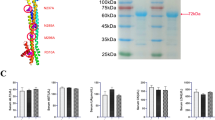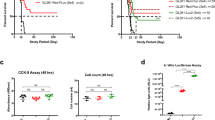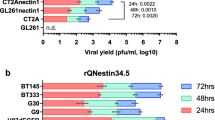Abstract
Purpose
Due to the recent rise in immunotherapy research to treat glioblastoma (GBM), immunocompetent mouse models have become increasingly crucial. However, the character and kinetics of the immune response against the most prevalent immunocompetent GBM models, GL261 and CT2A, have not been well studied, nor has the impact of commonly-used marker proteins and foreign antigens.
Methods
In this study, we compared the immune response in these models using flow cytometry and immunohistochemistry as well as investigated several factors that influence the immune response, including kinetics, tumor size, and expression of commonly-used marker proteins and foreign antigens. We hypothesize that these factors influence the immune response enough to warrant consideration when studying new immunotherapeutic approaches for GBM.
Results
CT2A-Luc, but not GL261-Luc2, drastically increased the number of T cells in the brain compared with wild-type controls, and significantly altered CT2A’s responsiveness to anti-PD-1 antibody therapy. Additionally, a larger cell inoculum size in the GL261 model increased the T cell response’s magnitude at day 28 post-injection. CT2A and GL261 models both stimulate a peak T cell immune response at day 21 post-injection.
Conclusions
Our results suggest that the impact of foreign proteins like luciferase on the intracranial immune response is dependent upon the model, with CT2A being more sensitive to added markers. In particular, luciferase expression in CT2A could lead to meaningful misinterpretations of results from immune checkpoint inhibitor (ICI) studies.





Similar content being viewed by others
Data availability
Datasets generated during the current study are available from the corresponding author on reasonable request.
References
McGranahan T, Therkelsen KE, Ahmad S, Nagpal S (2019) Current State of Immunotherapy for Treatment of Glioblastoma. Curr Treat Options Oncol 20:24. https://doi.org/10.1007/s11864-019-0619-4
Yersal Ö (2017) Clinical outcome of patients with glioblastoma multiforme: Single center experience. J Oncol Sci 3:123–126. https://doi.org/10.1016/j.jons.2017.10.005
Jackson CM, Choi J, Lim M (2019) Mechanisms of immunotherapy resistance: lessons from glioblastoma. Nat Immunol 20:1100–1109. https://doi.org/10.1038/s41590-019-0433-y
Schläger C, Körner H, Krueger M et al (2016) Effector T-cell trafficking between the leptomeninges and the cerebrospinal fluid. Nature 530:349–353. https://doi.org/10.1038/nature16939
Engelhardt B, Ransohoff RM (2012) Capture, crawl, cross: the T cell code to breach the blood–brain barriers. Trends Immunol 33:579–589. https://doi.org/10.1016/j.it.2012.07.004
Engelhardt B, Carare R, Bechmann I et al (2016) Vascular, glial, and lymphatic immune gateways of the central nervous system. Acta Neuropathol 132:317–338
Di Cintio F, Dal Bo M, Baboci L et al (2020) The Molecular and Microenvironmental Landscape of Glioblastomas: Implications for the Novel Treatment Choices. Front Neurosci 14:603647. https://doi.org/10.3389/fnins.2020.603647
Grabowski MM, Sankey EW, Ryan KJ et al (2020) Immune suppression in gliomas. J Neuro-Oncology 151:1. https://doi.org/10.1007/s11060-020-03483-y
Oh T, Fakurnejad S, Sayegh ET et al (2014) Immunocompetent murine models for the study of glioblastoma immunotherapy. J Transl Med 12:107. https://doi.org/10.1186/1479-5876-12-107
Szatmári T, Lumniczky K, Désaknai S et al (2006) Detailed characterization of the mouse glioma 261 tumor model for experimental glioblastoma therapy. Cancer Sci 97:546–553. https://doi.org/10.1111/j.1349-7006.2006.00208.x
Genoud V, Marinari E, Nikolaev SI et al (2018) Responsiveness to anti-PD-1 and anti-CTLA-4 immune checkpoint blockade in SB28 and GL261 mouse glioma models. Oncoimmunology 7:e1501137. https://doi.org/10.1080/2162402X.2018.1501137
Khalsa JK, Cheng N, Keegan J et al (2020) Immune phenotyping of diverse syngeneic murine brain tumors identifies immunologically distinct types. Nat Commun 11:3912. https://doi.org/10.1038/s41467-020-17704-5
Beug ST, Beauregard CE, Healy C et al (2017) Smac mimetics synergize with immune checkpoint inhibitors to promote tumour immunity against glioblastoma. Nat Commun 8:14278. https://doi.org/10.1038/ncomms14278
Woroniecka KI, Rhodin KE, Dechant C et al (2020) 4-1BB Agonism Averts TIL Exhaustion and Licenses PD-1 Blockade in Glioblastoma and Other Intracranial Cancers. Clin Cancer Res 26:1349–1358. https://doi.org/10.1158/1078-0432.CCR-19-1068
Nakashima H, Alayo QA, Penaloza-MacMaster P et al (2018) Modeling tumor immunity of mouse glioblastoma by exhausted CD8 + T cells. Sci Rep 8:208. https://doi.org/10.1038/s41598-017-18540-2
Amoozgar Z, Kloepper J, Ren J et al (2021) Targeting Treg cells with GITR activation alleviates resistance to immunotherapy in murine glioblastomas. Nat Commun 12:2582. https://doi.org/10.1038/s41467-021-22885-8
Belcaid Z, Berrevoets C, Choi J et al (2020) Low-dose oncolytic adenovirus therapy overcomes tumor-induced immune suppression and sensitizes intracranial gliomas to anti-PD-1 therapy. Neuro-Oncol Adv 2:1. https://doi.org/10.1093/noajnl/vdaa011
Ohlfest JR, Andersen BM, Litterman AJ et al (2013) Vaccine Injection Site Matters: Qualitative and Quantitative Defects in CD8 T Cells Primed as a Function of Proximity to the Tumor in a Murine Glioma Model. J Immunol 190:613–620. https://doi.org/10.4049/jimmunol.1201557
Cornelison RC, Brennan CE, Kingsmore KM, Munson JM (2018) Convective forces increase CXCR4-dependent glioblastoma cell invasion in GL261 murine model. Sci Rep 8:17057. https://doi.org/10.1038/s41598-018-35141-9
Sanchez VE, Lynes JP, Walbridge S et al (2020) GL261 luciferase-expressing cells elicit an anti-tumor immune response: an evaluation of murine glioma models. Sci Rep 10:11003. https://doi.org/10.1038/s41598-020-67411-w
QuPath: Open source software for digital pathology image analysis | Scientific Reports. https://www.nature.com/articles/s41598-017-17204-5. Accessed 3 Aug 2021
Hawkins E, Valley M, Scurria M et al (2007) One-Glo Luciferase Assay System: New Substrate, Better Reagent. Promega 97:30–32
Kefas B, Comeau L, Erdle N et al (2010) Pyruvate kinase M2 is a target of the tumor-suppressive microRNA-326 and regulates the survival of glioma cells. Neuro-Oncol 12:1102–1112. https://doi.org/10.1093/neuonc/noq080
Kefas B, Floyd DH, Comeau L et al (2013) A miR-297/hypoxia/DGK-α axis regulating glioblastoma survival. Neuro-Oncol 15:1652–1663. https://doi.org/10.1093/neuonc/not118
Kanazawa H, Ohsawa K, Sasaki Y et al (2002) Macrophage/Microglia-specific Protein Iba1 Enhances Membrane Ruffling and Rac Activation via Phospholipase C-γ-dependent Pathway *. J Biol Chem 277:20026–20032. https://doi.org/10.1074/jbc.M109218200
Imai Y, Ibata I, Ito D et al (1996) A novel gene iba1 in the major histocompatibility complex class III region encoding an EF hand protein expressed in a monocytic lineage. Biochem Biophys Res Commun 224:855–862. https://doi.org/10.1006/bbrc.1996.1112
Ito D, Imai Y, Ohsawa K et al (1998) Microglia-specific localisation of a novel calcium binding protein, Iba1. Brain Res Mol Brain Res 57:1–9. https://doi.org/10.1016/s0169-328x(98)00040-0
Ai W, Li H, Song N et al (2013) Optimal Method to Stimulate Cytokine Production and Its Use in Immunotoxicity Assessment. Int J Environ Res Public Health 10:3834–3842. https://doi.org/10.3390/ijerph10093834
Korin B, Ben-Shaanan TL, Schiller M et al (2017) High-dimensional, single-cell characterization of the brain’s immune compartment. Nat Neurosci 20:1300–1309. https://doi.org/10.1038/nn.4610
Clark AJ, Safaee M, Oh T et al (2014) Stable luciferase expression does not alter immunologic or in vivo growth properties of GL261 murine glioma cells. J Transl Med 12:345. https://doi.org/10.1186/s12967-014-0345-4
Podetz-Pedersen KM, Vezys V, Somia NV et al (2014) Cellular Immune Response Against Firefly Luciferase After Sleeping Beauty–Mediated Gene Transfer In Vivo. Hum Gene Ther 25:955–965. https://doi.org/10.1089/hum.2014.048
Liao JB, Ovenell KJ, Curtis EEM et al (2015) Preservation of tumor-host immune interactions with luciferase-tagged imaging in a murine model of ovarian cancer. J Immunother Cancer 3:16. https://doi.org/10.1186/s40425-015-0060-6
Baklaushev VP, Kilpeläinen A, Petkov S et al (2017) Luciferase Expression Allows Bioluminescence Imaging But Imposes Limitations on the Orthotopic Mouse (4T1) Model of Breast Cancer. Sci Rep 7:7715. https://doi.org/10.1038/s41598-017-07851-z
Liu H-S, Jan M-S, Chou C-K et al (1999) Is Green Fluorescent Protein Toxic to the Living Cells? Biochem Biophys Res Commun 260:712–717. https://doi.org/10.1006/bbrc.1999.0954
Taghizadeh RR, Sherley JL (2008) CFP and YFP, but Not GFP, Provide Stable Fluorescent Marking of Rat Hepatic Adult Stem Cells. J Biomed Biotechnol 2008:453590. https://doi.org/10.1155/2008/453590
Stripecke R, del Carmen Villacres M, Skelton DC et al (1999) Immune response to green fluorescent protein: implications for gene therapy. Gene Ther 6:1305–1312. https://doi.org/10.1038/sj.gt.3300951
Huntington JA, Stein PE (2001) Structure and properties of ovalbumin. J Chromatogr B Biomed Sci App 756:189–198. https://doi.org/10.1016/s0378-4347(01)00108-6
Karandikar SH, Sidney J, Sette A et al (2019) Identification of epitopes in ovalbumin that provide insights for cancer neoepitopes. JCI Insight 4:e127882
Bellone M, Cantarella D, Castiglioni P et al (2000) Relevance of the tumor antigen in the validation of three vaccination strategies for melanoma. J Immunol Baltim Md 1950 165:2651–2656. https://doi.org/10.4049/jimmunol.165.5.2651
Sosa RA, Murphey C, Ji N et al (2013) The Kinetics of Myelin Antigen Uptake by Myeloid Cells in the Central Nervous System during Experimental Autoimmune Encephalomyelitis. J Immunol 191:5848–5857. https://doi.org/10.4049/jimmunol.1300771
Radjavi A, Smirnov I, Derecki N, Kipnis J (2014) Dynamics of the meningeal CD4 + T-cell repertoire are defined by the cervical lymph nodes and facilitate cognitive task performance in mice. Mol Psychiatry 19:531–532. https://doi.org/10.1038/mp.2013.79
Rua R, McGavern DB (2018) Advances in Meningeal Immunity. Trends Mol Med 24:542–559. https://doi.org/10.1016/j.molmed.2018.04.003
Chandramohan V, Bao X, Yu X et al (2019) Improved efficacy against malignant brain tumors with EGFRwt/EGFRvIII targeting immunotoxin and checkpoint inhibitor combinations. J Immunother Cancer 7:142. https://doi.org/10.1186/s40425-019-0614-0
Choi SH, Stuckey DW, Pignatta S et al (2017) Tumor Resection Recruits Effector T Cells and Boosts Therapeutic Efficacy of Encapsulated Stem Cells Expressing IFNβ in Glioblastomas. Clin Cancer Res 23:7047–7058. https://doi.org/10.1158/1078-0432.CCR-17-0077
Acknowledgements
Thanks to the UVA Molecular Imaging Core, the Flow Cytometry Core, Biorepository and Tissue Research Core, and the Research Histology Core for their assistance.
Funding
Thanks to the Schiff Foundation, National Institute of Health Grants F99CA234954, R01CA180699, and R21NS108057 for funding.
Author information
Authors and Affiliations
Contributions
All authors contributed to the study conception and design. Material preparation, data collection and analysis were performed by BN, AW, NS, AX, LM, QZ, and ST. The first draft of the manuscript was written by BN and all authors commented on previous versions of the manuscript. All authors read and approved the final manuscript.
Corresponding author
Ethics declarations
Conflict of interest
No conflict of interest to report.
Ethical approval
Mouse protocols were approved by the IACUC committee at the University of Virginia (UVA).
Additional information
Publisher’s Note
Springer Nature remains neutral with regard to jurisdictional claims in published maps and institutional affiliations.
Supplementary Information
Below is the link to the electronic supplementary material.
Rights and permissions
About this article
Cite this article
Noffsinger, B., Witter, A., Sheybani, N. et al. Technical choices significantly alter the adaptive immune response against immunocompetent murine gliomas in a model-dependent manner. J Neurooncol 154, 145–157 (2021). https://doi.org/10.1007/s11060-021-03822-7
Received:
Accepted:
Published:
Issue Date:
DOI: https://doi.org/10.1007/s11060-021-03822-7




